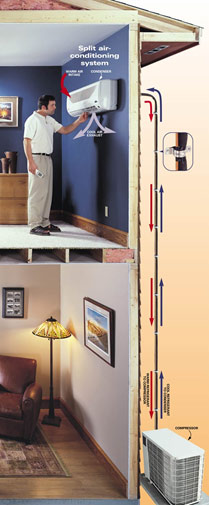 Mini Splits are small heat pumps that are typically used to service single or small groups of rooms. Computer controlled and equipped with inverter powered DC compressors, they literally sip energy compared to their centralized counterparts.
Mini Splits are small heat pumps that are typically used to service single or small groups of rooms. Computer controlled and equipped with inverter powered DC compressors, they literally sip energy compared to their centralized counterparts.
The indoor half of a mini split is designed to sit unobtrusively near the ceiling of a conditioned room and comes equipped with a whisper quiet (less than 40 db) fan. A small handheld remote control gives easy access to temperature, mode, and fan settings.
The outdoor unit is generally located near the indoor unit. It can be mounted on brackets attached to the wall or on a pad in much the same way as a traditional central air outdoor unit. Like a traditional outdoor unit, it houses the compressor, fan and associated electronics while also providing power for the indoor unit.
Refrigerant lines connect the two devices together to form a single heat pump system. Typically, mini splits come pre-charged with refrigerant for linesets as short as 15 feet and as long as 25 feet. For linesets that fall outside of this range, refrigerant can easily be added/removed.
Inverter powered DC motor technology is key to a mini split’s energy efficiency because it permits precise compressor power adjustments to match the required level of heating/cooling demand. This results in a more even output without start/stop events that draw large amounts of electricity
So just how effective are mini splits from an energy usage perspective? Well, 22 SEER cooling efficiencies and 9.8 HSPF heating efficiencies have now become typical. Also, since mini split technology represents a ductless solution, there are no duct work related losses to deal with either. All of the output is instead sent directly into the conditioned environment. Finally, these heat pumps are effective from 5 degrees to 115 degrees ambient making them usable over a wide range of geographical climates.
Consider mini splits for bedrooms and additions. With their super high efficiency, easy installation, and prices approaching $.11/BTU they are certainly worth a serious look when any HVAC change is planned!

